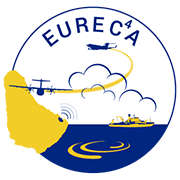EUREC4A–iso
The formation of trade wind cumulus clouds depends on the interplay between many physical processes at different scales. The large-scale circulation modulates vertical profiles of humidity and temperature by differential advection. This impacts the strength of vertical mixing of water vapor in particular between the boundary layer and the free troposphere. The balance between convective drying of the boundary layer by in-mixing of dry air from the free troposphere and turbulent moistening by ocean and rainfall evaporation is a central element in the process chain of shallow cumulus cloud formation. The aim of the EUREC4A-iso community is to investigate the distinct isotope signature associated with these different boundary layer moistening and drying processes and their relation to the macroscale cloud properties under different large-scale flow configurations.
The EUREC4A-iso endeavour has both experimental and modelling components. The experimental component aims at a complete characterization of the atmospheric and ocean water reservoirs in the winter trades during the EUREC4A campaign in 2020 with isotope measurements in water vapour, precipitation and ocean water using ship, aircraft and ground-based instrumentation. The complementing modelling efforts involve isotope-enabled numerical model simulations at the global, regional and LES scales.
First impressions of the use of stable water isotopes to investigate cold pool dynamics in the EUREC4A region have been collected during the pre-EUREC4A campaign between 20 January and 20 February 2018 at the Barbados Cloud Observatory ( BCO). These measurements of water isotopes in vapour at the BCO site and their interpretation using trajectory-based analyses of the air mass history provide interesting insight into potentially important dynamical drivers of the cold pool activity over BCO. The comprehensive setup planned for 2020 will allow exploring the usefulness of water isotopes for understanding cumulus dynamics at an even larger scale, thanks to the combination of numerical modeling and measurements covering the horizontal (ships and aircraft) and vertical (aircraft and lidar) dimensions.
BCO). These measurements of water isotopes in vapour at the BCO site and their interpretation using trajectory-based analyses of the air mass history provide interesting insight into potentially important dynamical drivers of the cold pool activity over BCO. The comprehensive setup planned for 2020 will allow exploring the usefulness of water isotopes for understanding cumulus dynamics at an even larger scale, thanks to the combination of numerical modeling and measurements covering the horizontal (ships and aircraft) and vertical (aircraft and lidar) dimensions.
PIs/Contact:
- Franziska Aemisegger and Heini Wernli - IAC, ETH Zürich
- Gilles Reverdin - LOCEAN, Université Pierre et Marie Curie, Paris
- Harald Sodemann - GFI, Universitetet i Bergen
- Stephan Pfahl - Freie Universität Berlin
- Camille Risi – LMD, Université Pierre et Marie Curie, Paris
- Cyrille Flamant – LATMOS, Université Paris-Saclay
